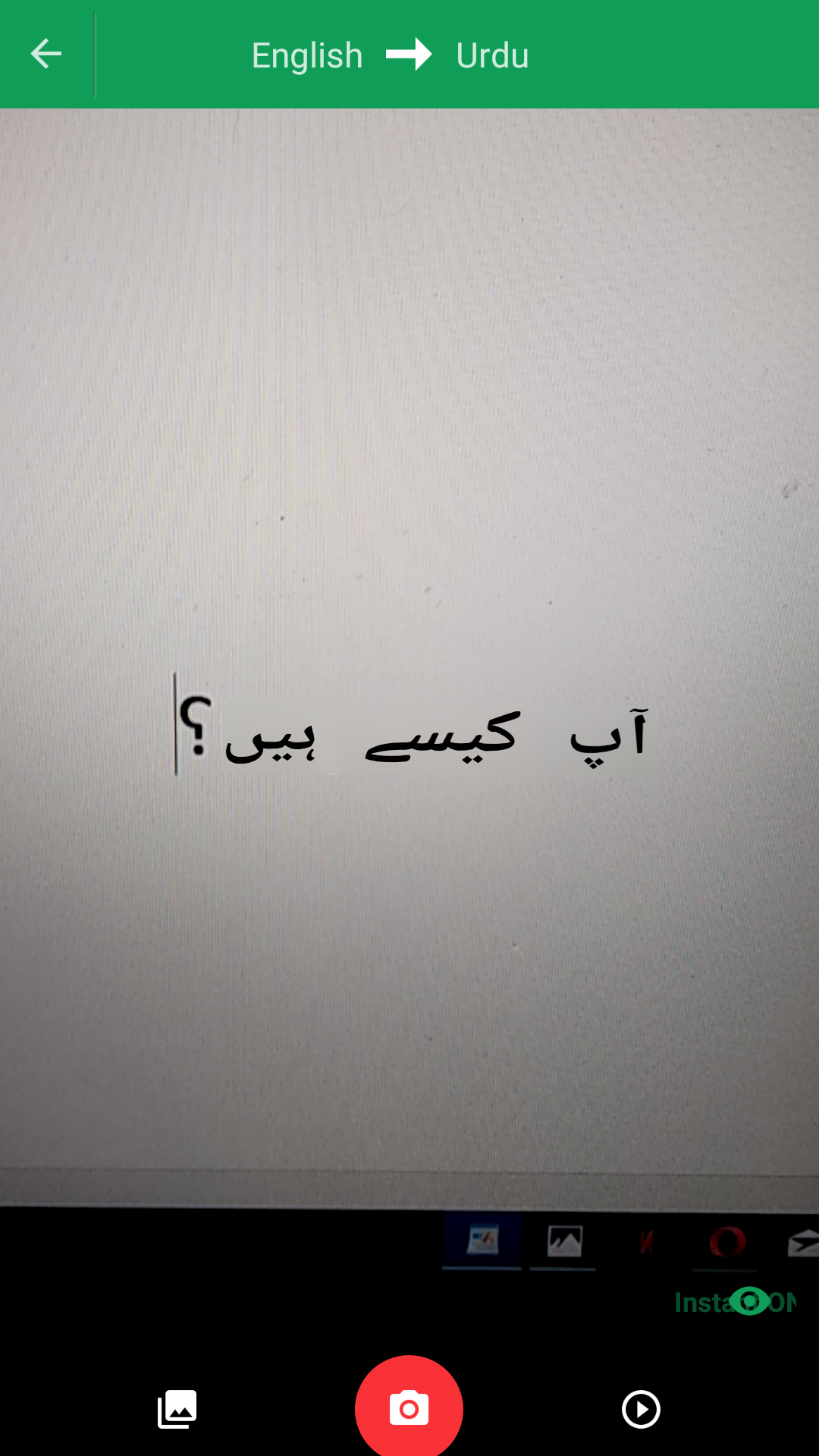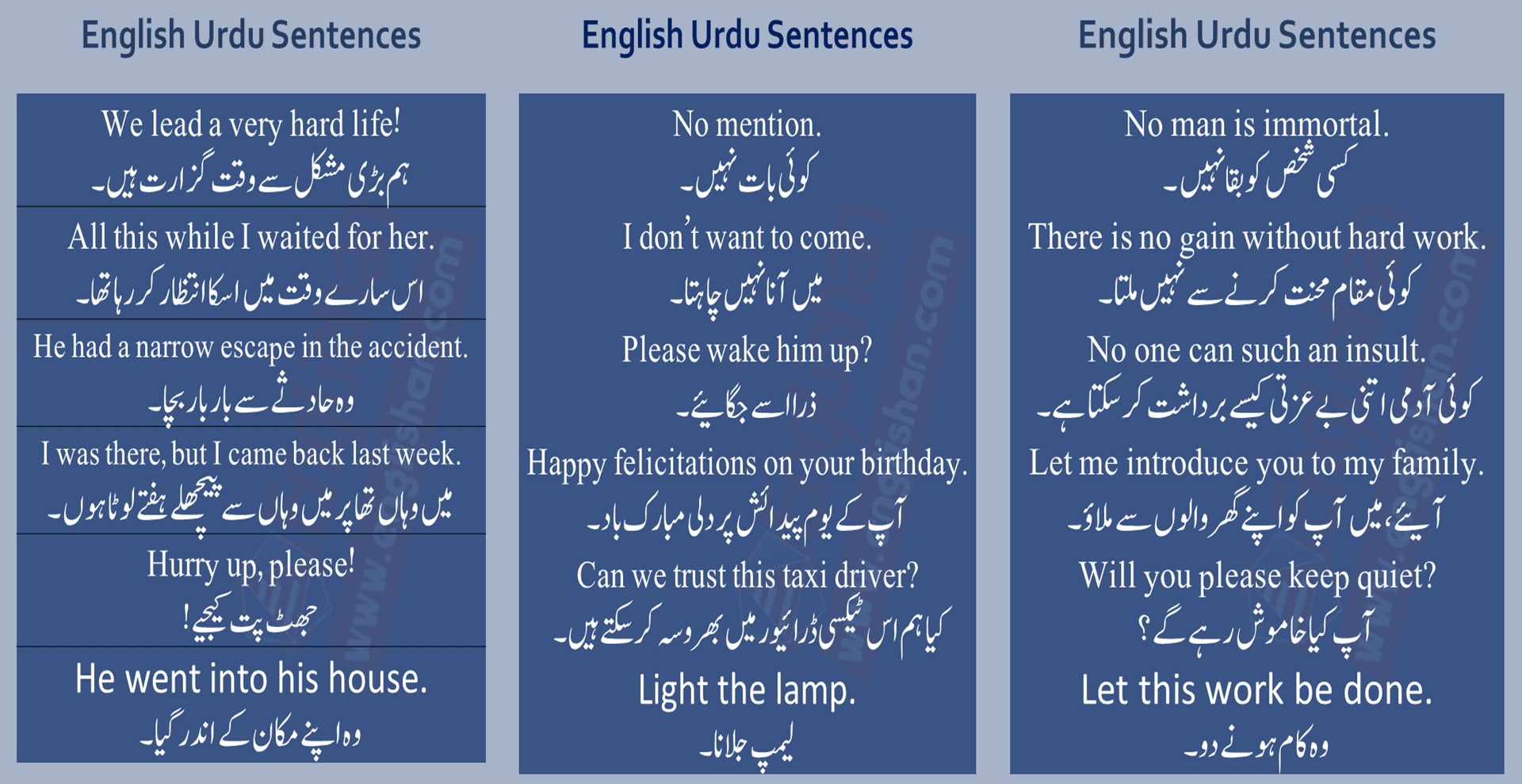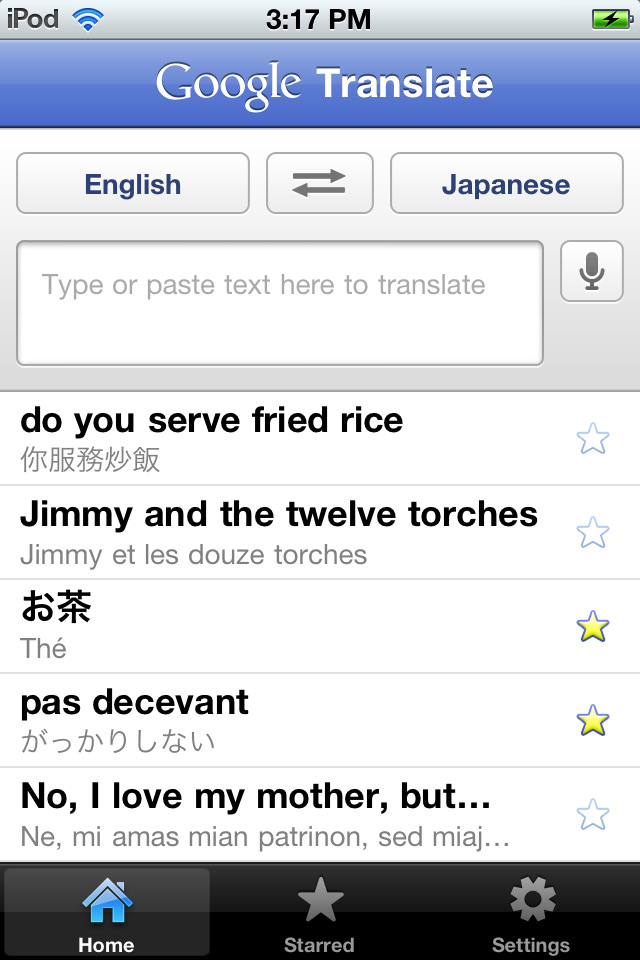Urdu English Translator comes with useful features to make word searching quicker compared from using a bulky dictionary. Users can either type in English or Urdu through the app's main interface. Users then select the language opposite from what they have entered earlier and the final output is displayed at the bottom. They can highlight and copy the translated word and press the app's Copy button. The newly translated word is saved in the device's temporary clipboard. If they wish to remove the saved word from the app's interface, they can quickly erase it with the Clear button.
The History button tracks back what the users entered for the past few session. This will help users remember the words they were looking for. The app has an additional feature to read and speak translated text, just make sure the English Audio and Urdu Audio features are already installed in the device. This audio feature is useful for conversing with anyone in real time, at the same time know the proper pronunciation of the translated word. The app also runs offline so that users don't have to connect online and search the right word. In this way, it serves as a dictionary on the go if an online connection is impossible geographically.
Since the app runs on most devices, any newly found words are shareable to social media platforms. Users can simply paste the words on social media sites like Facebook or Twitter so that their personal contacts will discover their attempt to expand their vocabulary. Travelers and students will benefit from the app because it provides everything they needed when it comes to communicating between English and Urdu. The app is also created as a learning tool for everyone's convenience. Users can read new words while traveling abroad, playing online games with their teammates, listening during classes, boarding on a public transit, chatting with friends online or physically, and so much more scenarios.
All of these benefits eradicate the problem of language barrier despite the app only providing simple word translation. People will recognize the efforts of users attempting to connect with them by using common vocabulary in English or Urdu. It comes with a camera translation feature, which works for major Asian characters . As such, it's one of the best translation apps in the Asian market. It can translate text messages, voice, as well as conversational translations.
It is also capable of copying and sharing translated texts through email, SMS, pdf file, and social media. When you translate speech, the voice output can be set to male or female, and can be slowed down for easier emulation. This is a great feature for those who want to learn how to speak a new language. For learning on-the-go, install this app on your apple watch! This feature-rich translator could use an offline mode, though, just like most other major translator apps and also features alternative translations. Translate's online translations have beenpowered by neural machine translation since 2016, and a few algorithms made their way to mobile platforms in 2018.
Like the previously used phrase-based machine learning approach, NMT leverages hundreds of millions of example translations of things like articles, books, documents, and search results. Launched in April 2006 as a statistical machine translation service, it used United Nations and European Parliament documents and transcripts to gather linguistic data. Rather than translating languages directly, it first translates text to English and then pivots to the target language in most of the language combinations it posits in its grid, with a few exceptions including Catalan-Spanish. During a translation, it looks for patterns in millions of documents to help decide which words to choose and how to arrange them in the target language. Its accuracy, which has been criticized and ridiculed on several occasions, has been measured to vary greatly across languages.
Originally only enabled for a few languages in 2016, GNMT is now used in all 109 languages in the Google Translate roster as of January 2022. The Hishell google translate urdu to english voice is a new product based on artificial intelligence technology. It can flexibly translate and translate different languages in many countries.
Moreover, it also supports the conversion of many kinds of texts. The problem is to make your life more convenient and faster, so that you can more fully experience the convenience and speed brought by the development of science and technology. Due to differences between languages in investment, research, and the extent of digital resources, the accuracy of Google Translate varies greatly among languages. Most languages from Africa, Asia, and the Pacific, tend to score poorly in relation to the scores of many well-financed European languages, Afrikaans and Chinese being the high-scoring exceptions from their continents. No languages indigenous to Australia or the Americas are included within Google Translate.
A 2010 analysis indicated that French to English translation is relatively accurate, and 2011 and 2012 analyses showed that Italian to English translation is relatively accurate as well. However, if the source text is shorter, rule-based machine translations often perform better; this effect is particularly evident in Chinese to English translations. While edits of translations may be submitted, in Chinese specifically one cannot edit sentences as a whole. Instead, one must edit sometimes arbitrary sets of characters, leading to incorrect edits.
Formerly one would use Google Translate to make a draft and then use a dictionary and common sense to correct the numerous mistakes. As of early 2018 Translate is sufficiently accurate to make the Russian Wikipedia accessible to those who can read English. The quality of Translate can be checked by adding it as an extension to Chrome or Firefox and applying it to the left language links of any Wikipedia article. One can translate from a book by using a scanner and an OCR like Google Drive, but this takes about five minutes per page. Google Translate produces approximations across languages of multiple forms of text and media, including text, speech, websites, or text on display in still or live video images. For some languages, Google Translate can synthesize speech from text, and in certain pairs it is possible to highlight specific corresponding words and phrases between the source and target text.
Results are sometimes shown with dictional information below the translation box, but it is not a dictionary and has been shown to invent translations in all languages for words it does not recognize. If "Detect language" is selected, text in an unknown language can be automatically identified. In the web interface, users can suggest alternate translations, such as for technical terms, or correct mistakes. These suggestions may be included in future updates to the translation process. If a user enters a URL in the source text, Google Translate will produce a hyperlink to a machine translation of the website. Users can save translation proposals in a "phrasebook" for later use.
For some languages, text can be entered via an on-screen keyboard, through handwriting recognition, or speech recognition. It is possible to enter searches in a source language that are first translated to a destination language allowing one to browse and interpret results from the selected destination language in the source language. Google Translate, like other automatic translation tools, has its limitations.
Grammatically, for example, Google Translate struggles to differentiate between imperfect and perfect aspects in Romance languages so habitual and continuous acts in the past often become single historical events. Although seemingly pedantic, this can often lead to incorrect results which would have been avoided by a human translator. Knowledge of the subjunctive mood is virtually non-existent.[unreliable source?
] Moreover, the formal second person is often chosen, whatever the context or accepted usage.[unreliable source? ] Since its English reference material contains only "you" forms, it has difficulty translating a language with "you all" or formal "you" variations. We have developed a UX-friendly, easy to use free translations app, available for iOS and Android on your phone, and any desktop. However, consider that machine-generated translations, even with AI and neural networks involved, are not guaranteed to be fully accurate.
They can't be used for business or when submitting translated media to government offices or academic institutions. That's why the ranking of apps here puts emphasis on the superiority of human translations, hence apps that connect users to professional human translators rank high in the list above. Current statusActiveGoogle Translate is a multilingual neural machine translation service developed by Google to translate text, documents and websites from one language into another. It offers a website interface, a mobile app for Android and iOS, and an API that helps developers build browser extensions and software applications.
As of January 2022, Google Translate supports 109 languages at various levels and as of April 2016, claimed over 500 million total users, with more than 100 billion words translated daily. Although Google deployed a new system called neural machine translation for better quality translation, there are languages that still use the traditional translation method called statistical machine translation. It is a rule-based translation method that utilizes predictive algorithms to guess ways to translate texts in foreign languages. It aims to translate whole phrases rather than single words then gather overlapping phrases for translation. Moreover, it also analyzes bilingual text corpora to generate statistical model that translates texts from one language to another. The pros and cons of Google translate not only impact professional translators in the language service industry, but rather anyone who chooses to use it as a translation tool.
Certainly, online public access to a free, quick, and relatively accurate translation method represents significant progress in translation technology. But when one directly compares translation quality and accuracy using Google Translate with that of an experienced human translator, there is no real comparison. In November 2016, Google transitioned its translating method to a system called neural machine translation.
It uses deep learning techniques to translate whole sentences at a time, which has been measured to be more accurate between English and French, German, Spanish, and Chinese. No measurement results have been provided by Google researchers for GNMT from English to other languages, other languages to English, or between language pairs that do not include English. As of 2018, it translates more than 100 billion words a day. NMT translates complete sentences, instead of just parts of a sentence, while also looking at the broader context for more accurate results. Before this change, you got NMT only when the app was online, leaving offline translations to rely on more basic tools.
You can download a language pack by going to the list of languages and tapping the down-arrow download button next to the language pack you want. Each language set is between 35MB and 45MB, so they won't take up much space on your phone. The Hishell google translate urdu to english voice belongs to a new type of intelligent device.
It is a research result based on artificial intelligence technology, which can translate between different languages. The synchronous translation function can also translate under very low delay. The function finally achieves the effect of simultaneous translation.
Moreover, Linguee comes with an offline mode, pronunciation guides, and example sentences. You can use Linguee without Internet connection provided that you have downloaded the necessary language packs. The pronunciation guides are in written and audio formats.
The audio pronunciation guides were recorded by professional speakers. On the other hand, the "example sentences" feature helps users in learning how to use words and phrases in a new language. Google Translate has one of the most advanced if not the most advanced free translation software.
The great tech is what makes Google Translate one of the most popular translation apps in the world as it can be used for formal and informal speech. It is the result of years of development and the most recent relevant technological advancements. These manifest in the extensive range of features the app offers. It can translate text in more than 100 languages and is even capable of offline translations in multiple languages . Additionally, it can translate text and numbers as taken by a device's camera or by analyzing a photo or image fed into the app . Before October 2007, for languages other than Arabic, Chinese and Russian, Google Translate was based on SYSTRAN, a software engine which is still used by several other online translation services such as Babel Fish .
From October 2007, Google Translate used proprietary, in-house technology based on statistical machine translation instead, before transitioning to neural machine translation. The machine translation feature of this app is referred to as the Quick Translations on iOS or Free Translations on Android. To use it, select the language of origin and target language you want, and enter the word, phrase, or sentence you intend the language translation app to process in the upper box. Google has crowdsourcing features for volunteers to be a part of its "Translate Community", intended to help improve Google Translate's accuracy. In August 2016, a Google Crowdsource app was released for Android users, in which translation tasks are offered.
First, Google will show a phrase that one should type in the translated version. Second, Google will show a proposed translation for a user to agree, disagree, or skip. Third, users can suggest translations for phrases where they think they can improve on Google's results.
In January 2015, the apps gained the ability to propose translations of physical signs in real time using the device's camera, as a result of Google's acquisition of the Word Lens app. Microsoft Translator, moreover, has a rich phrasebook as well as pronunciation guides, which are useful for those who want to learn how to speak essential foreign language phrases often encountered during travels. You can hear translated phrases out loud or view transliterations to help you speak and remember foreign words or phrases better. Additionally, this app is capable of sharing translations with other apps and doing text translations while accessing other apps through the context menu. SayHi is dubbed as the "voice translator for everyone" and can be used for formal and informal speech. This is one of the most popular translation apps and it's free for iOS and Android.
It has made the rounds in major traditional and online media such as the NBC Today show, TechCrunch, Lifehacker, and Gizmodo. The app supports multiple languages including Arabic, Catalan, Chinese, Czech, Danish, Filipino, Estonian, Finnish, French, German, Greek, Creole, Hebrew, Hindi, Norwegian, Hungarian, Indonesian, Korean, Japanese, Italian,. Latvian, Korean, Slovenian, Spanish, Swedish, Thai, Turkish, Vietnamese, Romanian, Russian, Swahili, Polish, and Lithuanian. Today, let's share with you a NetEase translator and a Hishell google translate urdu to english voice.
Google Translate is among one of the best free tools for translating languages, whether online or offline. The application just simply works and translates the content without any hassle and fuss. The translations done through Google Translate are accurate for the most part and work well.
Google's latest introduction of NMT is allowing their AI to evaluate the greater context of words and phrases to better mimic a real person, which has lead to smoother and easier to read translations. Additionally, these services are now available for offline use—perfect for travelling or when you don't have access to the internet. But despite their best efforts, Google Translate is hardly a reliable and consistent translation solution, especially for businesses. You'll also notice three options at the bottom of the text box. They allow you to switch to the camera for real-time translations or to take photos to upload, open up conversation mode, or turn on voice to speak your required phrase or word instead of typing it.
To translate handwritten text, just click the pen icon on the right-hand side of the screen to open the handwriting screen. Do you want to translate your audio or voice notes into text? Now, you can do that and more with VEED's easy to use audio translator! Transcribe voice recordings, podcasts, speeches, dialogues, and much more. VEED's powerful audio translator can automatically detect any language in your audio files (mp3, wav, m4a, etc.) and transcribe it to text in a single click!

























No comments:
Post a Comment
Note: Only a member of this blog may post a comment.